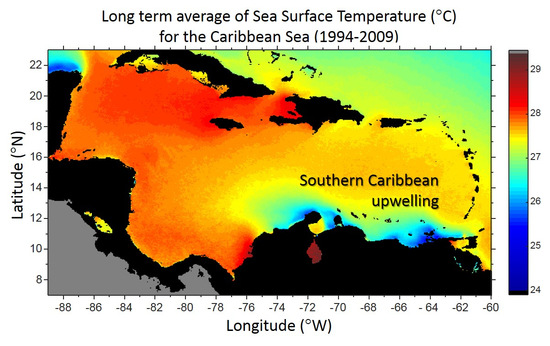Description and Mechanisms of the Mid-Year Upwelling in the Southern Caribbean Sea from Remote Sensing and Local Data
Abstract
:1. Introduction
2. Data and Analysis Methods
2.1. Synoptic Satellite Data
2.2. In Situ Data
3. Results
3.1. Temporal and Spatial Temperature Characteristics of the Mid-Year Upwelling
3.2. Regional Wind-Induced Transport
3.3. Nearshore Wind-Derived Parameters
3.4. Caribbean Current Maximum Speed
3.5. Averages over the West and East Upwelling Areas
3.6. Upwelling Relationship with Forcing Mechanisms
4. Discussion
5. Conclusions
- The mid-year upwelling contributes to the extension (December to August) of the upwelling season of the southern Caribbean (previously known from December to April).
- The principal upwelling mechanism in the southern Caribbean upwelling system, for both the principal and the mid-year upwelling seasons, is the cross-shore Ekman transport, which accounts for more than 78% of the total wind-driven transport.
- The wind curl integrated over the first 100 km from the coast has a better correlation with the upwelling SST signature than the cross-shore Ekman transport. The process most likely involved is changes in the isopycnal depth due to the curl of the wind. The total transport, calculated by adding both wind-driven mechanisms, has significantly higher correlations with SST than with the cross-shore Ekman transport alone.
- The mid-year upwelling is not caused by dynamic uplift due to instabilities of the Caribbean Current; however, it might be enhanced by the seasonal intensification of the Caribbean Current.
Acknowledgments
Author Contributions
Conflicts of Interest
References
- Herrera, L.; Febres-Ortega, G. Kinematics of the wind-generated velocity field in the surface waters off eastern Venezuela, Caribbean Sea. Bol. Inst. Oceanogr. Univ. Oriente 1975, 14, 165–186. [Google Scholar]
- Isemer, H.-J.; Bunker, A.F.; Hasse, L. The Bunker Climate Atlas of the North Atlantic Ocean; Air–Sea Interactions; Springer: Berlin, Germany, 1985. [Google Scholar]
- Muller-Karger, F.E.; Castro, R.A. Mesoscale Processes Affecting Phytoplankton Abundance in the Southern Caribbean Sea. Cont. Shelf Res. 1994, 14, 199–221. [Google Scholar] [CrossRef]
- Muller-Karger, F.; Varela, R.; Thunell, R.; Astor, Y.; Zhang, H.; Luerssen, R.; Hu, C. Processes of coastal upwelling and carbon flux in the Cariaco Basin. Deep Sea Res. Part II Top. Stud. Oceanogr. 2004, 51, 927–943. [Google Scholar] [CrossRef]
- Muller-Karger, F.; Varela, R.; Thunnell, R.; Scranton, M.; Taylor, G.; Capelo, J.; Astor, Y.; Tappa, E.; Akl, J.; Ho, T.-Y. Características de la fosa de Cariaco y su importancia desde el punto de vista oceanográfico. Mem. Fund. La Salle Cien. Nat. 2004, 161–162, 215–234. [Google Scholar]
- Peterson, L.C.; Haug, G.H. Variability in the mean latitude of the Atlantic Intertropical Convergence Zone as recorded by riverine input of sediments to the Cariaco Basin (Venezuela). Palaeogeogr. Palaeoclimatol. Palaeoecol. 2006, 234, 97–113. [Google Scholar] [CrossRef]
- Castellanos, P.; Varela, R.; Muller-Karger, F. Descripción de las áreas de surgencia al sur del Mar Caribe examinadas con el sensor infrarrojo AVHRR. Mem. Fund. La Salle Cien. Nat. 2002, 154, 55–76. [Google Scholar]
- Rueda-Roa, D.T.; Muller-Karger, F.E. The southern Caribbean upwelling system: Sea surface temperature, wind forcing and chlorophyll concentration patterns. Deep Sea Res. Part I Oceanogr. Res. Pap. 2013, 78, 102–114. [Google Scholar] [CrossRef]
- Rueda, D. Variabilidad Temporal de la Distribución Vertical de la Biomasa Fitoplanctónica en la Cuenca de Cariaco y Sus Relaciones con Los Aspectos Hidrográficos del Estrato Superficial (1996–1998). Master’s Thesis, Universidad de Oriente, Puerto La Cruz, Venezuela, 2000. [Google Scholar]
- Rueda-Roa, D. On the Spatial and Temporal Variability of Upwelling in the Southern Caribbean Sea and Its Influence on the Ecology of Phytoplankton and of the Spanish Sardine (Sardinella Aurita). Ph.D. Thesis, University of South Florida, Tampa, FL, USA, 2012. [Google Scholar]
- Astor, Y.; Muller-Karger, F.; Scranton, M.I. Seasonal and interannual variation in the hydrography of the Cariaco Basin: Implications for basin ventilation. Cont. Shelf Res. 2003, 23, 125–144. [Google Scholar] [CrossRef]
- Goni, M.A.; Aceves, H.L.; Thunell, R.C.; Tappa, E.; Black, D.; Astor, Y.; Varela, R.; Muller-Karger, F. Biogenic fluxes in the Cariaco Basin: A combined study of sinking particulates and underlying sediments. Deep Sea Res. Part I Oceanogr. Res. Pap. 2003, 50, 781–807. [Google Scholar] [CrossRef]
- Andrade, C.A.; Barton, E.D. The Guajira upwelling system. Cont. Shelf Res. 2005, 25, 1003–1022. [Google Scholar] [CrossRef]
- Gill, A.E. International Geophysics, 30: Atmosphere-Ocean Dynamics; Elsevier: Burlington, VT, USA, 1982. [Google Scholar]
- Oey, L.Y. A forcing mechanism for the poleward flow off the southern California coast. J. Geophys. Res. Oceans 1999, 104, 13529–13539. [Google Scholar] [CrossRef]
- Capet, X.; Marchesiello, P.; McWilliams, J. Upwelling response to coastal wind profiles. Geophys. Res. Lett. 2004, 31. [Google Scholar] [CrossRef]
- Tomczak, M. Upwelling Dynamics in Deep and Shallow Water, Chapter 6. In Shelf and Estuarine Oceanography: An Introduction; Flinders University of South Australia: Adelaide, Australia, 1996. [Google Scholar]
- Johns, W.E.; Townsend, T.L.; Fratantoni, D.M.; Wilson, W.D. On the Atlantic inflow to the Caribbean Sea. Deep Sea Res. Part I Oceanogr. Res. Pap. 2002, 49, 211–243. [Google Scholar] [CrossRef]
- Rhein, M.; Kirchner, K.; Mertens, C.; Steinfeldt, R.; Walter, M.; Fleischmann-Wischnath, U. Transport of South Atlantic Water through the passages south of Guadeloupe and across 16°N, 2000–2004. Deep Sea Res. Part I Oceanogr. Res. Pap. 2005, 52, 2234–2249. [Google Scholar] [CrossRef]
- Hu, C.; Muller-Karger, F.; Murch, B.; Myhre, D.; Taylor, J.; Luerssen, R.; Moses, C.; Zhang, C.; Gramer, L.; Hendee, J. Building an Automated Integrated Observing System to Detect Sea Surface Temperature Anomaly Events in the Florida Keys. IEEE Trans. Geosci. Remote Sens. 2009, 47, 2071–2084. [Google Scholar] [CrossRef]
- Hoffman, R.N.; Leidner, S.M. An introduction to the near-real-time QuikSCAT data. Weather Forecast. 2005, 20, 476–493. [Google Scholar] [CrossRef]
- Freilich, M.H.; Dunbar, R.S. The accuracy of the NSCAT 1 vector winds: Comparisons with national data buoy center buoys. J. Geophys. Res. Oceans 1999, 104, 11231–11246. [Google Scholar] [CrossRef]
- Bakun, A. Coastal Upwelling Indices, West Coast of North America, 1946–1971; NOAA Technical Report NMFS SSRF-671; U.S. Department of Commerce: Washington, DC, USA, 1973; p. 103. [Google Scholar]
- Oey, L.Y.; Ezer, T.; Wang, D.P.; Fan, S.J.; Yin, X.Q. Loop Current warming by Hurricane Wilma. Geophys. Res. Lett. 2006, 33. [Google Scholar] [CrossRef]
- Oey, L.-Y.; Ezer, T.; Wang, D.-P.; Yin, X.-Q.; Fan, S.-J. Hurricane-induced motions and interaction with ocean currents. Cont. Shelf Res. 2007, 27, 1249–1263. [Google Scholar] [CrossRef]
- Stewart, R.H. Introduction to Physical Oceanography; Texas A & M University: College Station, TX, USA, 2008. [Google Scholar]
- Mendo, J.; Pizarro, L.; Castillo, S. Monthly Turbulence and Ekman Transport Indexes 1953 to 1985, Based on Local Wind Records from Trujillo and Callao, Peru. In The Peruvian Anchoveta and Its Upwelling Ecosystem: Three Decades of Change; Pauly, D., Tsukayama, I., Eds.; ICLARM: Manila, Philippines, 1987; Volume 15, pp. 75–88. [Google Scholar]
- Castelao, R.M.; Barth, J.A. Upwelling around Cabo Frio, Brazil: The importance of wind stress curl. Geophys. Res. Lett. 2006, 33. [Google Scholar] [CrossRef]
- Smith, R.L. Upwelling. Oceanogr. Mar. Biol. Ann. Rev. 1968, 6, 11–46. [Google Scholar]
- Lagerloef, G.S.; Mitchum, G.T.; Lukas, R.B.; Niiler, P.P. Tropical pacific near-surface currents estimated from altimeter, wind, and drifter data. J. Geophys. Res. Oceans 1999, 104, 23313–23326. [Google Scholar] [CrossRef]
- Bonjean, F.; Lagerloef, G.S. Diagnostic model and analysis of the surface currents in the tropical Pacific Ocean. J. Phys. Oceanogr. 2002, 32, 2938–2954. [Google Scholar] [CrossRef]
- Muller-Karger, F.; Varela, R.; Thunell, R.; Scranton, M.; Bohrer, R.; Taylor, G.; Capelo, J.; Astor, Y.; Tappa, E.; Ho, T.Y. Annual cycle of primary production in the Cariaco Basin Response to upwelling and implications for vertical export. J. Geophys. Res. Oceans 2001, 106, 4527–4542. [Google Scholar] [CrossRef]
- Scranton, M.I.; McIntyre, M.; Astor, Y.; Taylor, G.T.; Muller-Karger, F.; Fanning, K. Temporal variability in the nutrient chemistry of the Cariaco Basin. In Past and Present Marine Water Column Anoxia; Nato Science Series IV; Neretin, L.N., Ed.; Springer: New York, NY, USA, 2006; Volume 64, pp. 139–160. [Google Scholar]
- Thunell, R.; Benitez-Nelson, C.; Varela, R.; Astor, Y.; Muller-Karger, F. Particulate organic carbon fluxes along upwelling-dominated continental margins: Rates and mechanisms. Glob. Biogeochem. Cycles 2007, 21, GB1022. [Google Scholar] [CrossRef]
- Taylor, G.T.; Muller-Karger, F.E.; Thunell, R.C.; Scranton, M.I.; Astor, Y.; Varela, R.; Trocoli-Ghinaglia, L.; Lorenzoni, L.; Fanning, K.A.; Hameed, S. Ecosystem responses in the southern Caribbean Sea to global climate change. Proc. Natl. Acad. Sci. USA 2012, 109, 19315–19320. [Google Scholar] [CrossRef] [PubMed]
- Andrade, C.A. The Circulation and Variability of the Colombian Basin in the Caribbean Sea. Ph.D. Thesis, University of Wales, Cardiff, UK, 2000; p. 227. [Google Scholar]
- Amador, J. A climate feature of the tropical Americas: The trade wind easterly jet. Tóp. Meteorol. Oceanogr. 1998, 5, 91–102. [Google Scholar]
- Wang, C. Variability of the Caribbean Low-Level Jet and its relations to climate. Clim. Dyn. 2007, 29, 411–422. [Google Scholar] [CrossRef]
- Pickett, M.H.; Tang, W.; Rosenfeld, L.K.; Wash, C.H. QuikSCAT satellite comparisons with nearshore buoy wind data off the U. S. West Coast. J. Atmos. Ocean. Technol. 2003, 20, 1869–1879. [Google Scholar] [CrossRef]
- Jouanno, J.; Sheinbaum, J.; Barnier, B.; Molines, J.M.; Candela, J. Seasonal and Interannual Modulation of the Eddy Kinetic Energy in the Caribbean Sea. J. Phys. Oceanogr. 2012, 42, 2041–2055. [Google Scholar] [CrossRef]
- Schwing, F.B.; Blanton, J.O. The Use of Land and Sea Based Wind Data in a Simple Circulation Model. J. Phys. Oceanogr. 1984, 14, 193–197. [Google Scholar] [CrossRef]
- Fréon, P.; Ans, L. Comparison between coastal wind data, merchant ship data and sea surface temperature in northeastern Venezuela. In The Sardine (Sardinella Aurita), Its Environment and Exploitation in Eastern Venezuela; Fréon, P., Mendoza, J., Eds.; IRD Editions: Paris, France, 2003; pp. 233–262. [Google Scholar]
- Carton, J.A.; Chao, Y. Caribbean Sea eddies inferred from TOPEX/Poseidon altimetry and a 1/6 Atlantic Ocean model simulation. J. Geophys. Res. Oceans 1999, 104, 7743–7752. [Google Scholar] [CrossRef]
- Murphy, S.J.; Hurlburt, H.E.; O’Brien, J.J. The connectivity of eddy variability in the Caribbean Sea, the Gulf of Mexico, and the Atlantic Ocean. J. Geophys. Res. Oceans 1999, 104, 1431–1453. [Google Scholar] [CrossRef]
- Richardson, P.L. Caribbean current and eddies as observed by surface drifters. Deep Sea Res. Part II Top. Stud. Oceanogr. 2005, 52, 429–463. [Google Scholar] [CrossRef]
- Molinari, R.L.; Spillane, M.; Brooks, I.; Atwood, D.; Duckett, C. Surface current in the Caribbean Sea as deduced from Lagrangian observations. J. Geophys. Res. Oceans 1981, 86, 6537–6542. [Google Scholar] [CrossRef]
- Pratt, R.W.; Maul, G.A. Sea surface height variability of the Intra-Americas Sea from TOPEX/Poseidon satellite altimetry: 1992–1995. Bull. Mar. Sci. 2000, 67, 687–708. [Google Scholar]
- Andrade, C.A.; Barton, E.D. Eddy development and motion in the Caribbean Sea. J. Geophys. Res. Oceans 2000, 105, 26191–26201. [Google Scholar] [CrossRef]
- Alvera-Azcárate, A.; Barth, A.; Weisberg, R.H. The surface circulation of the Caribbean Sea and the Gulf of Mexico as inferred from satellite altimetry. J. Phys. Oceanogr. 2009, 39, 640–657. [Google Scholar] [CrossRef]
- Stromme, T.; Saetersdal, G. Final Report, Surveys of the Fish Resources in the Shelf Areas between Surinam and Colombia, 1988; Reports on Surveys with RV ‘Dr. Fridtjof. Nansen’; Institute of Marine Research: Bergen, Norway, 1989. [Google Scholar]
- Jury, M.R. Eastern Venezuela coastal upwelling in context of regional weather and climate variability. Reg. Stud. Mar. Sci. 2017, 18, 219–228. [Google Scholar] [CrossRef]
- Herrera, L.; Febres, G.; Andres, J. Distribución de las masas de agua y sus vinculaciones dinámicas en el sector centro-occidental venezolano, mar caribe. Bol. Inst. Oceanogr. Univ. Oriente 1980, 19, 93–118. [Google Scholar]
- Lorenzoni, L.; Hu, C.; Varela, R.; Arias, G.; Guzman, L.; Muller-Karger, F. Bio-optical characteristics of Cariaco Basin (Caribbean Sea) waters. Cont. Shelf Res. 2011, 31, 582–593. [Google Scholar] [CrossRef]
- Robinson, M.J. Improvements to a Real-Time, Satellite-Derived Surface Current Product (OSCAR) and Evaluation in the Intra-American Sea. Master’s Thesis, University of South Florida, Tampa, FL, USA, 2011. [Google Scholar]
- Johnson, E.S.; Bonjean, F.; Lagerloef, G.S.; Gunn, J.T.; Mitchum, G.T. Validation and error analysis of OSCAR sea-surface currents. J. Atmos. Ocean. Technol. 2007, 24, 688–701. [Google Scholar] [CrossRef]
- Koracin, D.; Dorman, C.E.; Dever, E.P. Coastal perturbations of marine layer winds, wind stress, and wind stress curl along California and Baja California in June 1999. J. Phys. Oceanogr. 2004, 34, 1152–1173. [Google Scholar] [CrossRef]
- Ruiz-Ochoa, M.; Beier, E.; Bernal, G.; Barton, E.D. Sea surface temperature variability in the Colombian Basin, Caribbean Sea. Deep Sea Res. Part I Oceanogr. Res. Pap. 2012, 64, 43–53. [Google Scholar] [CrossRef]
- Song, H.; Miller, A.J.; Cornuelle, B.D.; Di Lorenzo, E. Changes in upwelling and its water sources in the California Current System driven by different wind forcing. Dyn. Atmos. Oceans 2011, 52, 170–191. [Google Scholar] [CrossRef]
- Jouanno, J.; Sheinbaum, J.; Barnier, B.; Molines, J.-M. The mesoscale variability in the Caribbean Sea. Part II: Energy sources. Ocean Model. 2009, 26, 226–239. [Google Scholar] [CrossRef]
- Nykjær, L.; Van Camp, L. Seasonal and Interannual Variability of Coastal Upwelling along Northwest Africa and Portugal from 1981 to 1991. J. Geophys. Res. Oceans 1994, 99, 14197–14207. [Google Scholar] [CrossRef]
- Benazzouz, A.; Pelegrí, J.L.; Demarcq, H.; Machín, F.; Mason, E.; Orbi, A.; Peña-Izquierdo, J.; Soumia, M. On the temporal memory of coastal upwelling off NW Africa. J. Geophys. Res. Oceans 2014, 119, 6356–6380. [Google Scholar] [CrossRef]
- Zhaoyun, C. Coastal Upwelling Study: Observations, Dynamic Analysis and Modelling. Ph.D. Thesis, University of Delaware, Newark, DE, USA, 2014. [Google Scholar]
- Jewell, P.W. Mass balance models of Ekman transport and nutrient fluxes in coastal upwelling zones. Glob. Biogeochem. Cycles 1994, 8, 165–177. [Google Scholar] [CrossRef]
- Demarcq, H.; Faure, V. Coastal upwelling and associated retention indices derived from satellite SST. Application to Octopus vulgaris recruitment. Oceanol. Acta 2000, 23, 391–408. [Google Scholar] [CrossRef]
- Marchesiello, P.; Estrade, P. Upwelling limitation by onshore geostrophic flow. J. Mar. Res. 2010, 68, 37–62. [Google Scholar] [CrossRef]
- Estrade, P.; Marchesiello, P.; Verdière, D.; Colin, A.; Roy, C. Cross-shelf structure of coastal upwelling: A two-dimensional extension of Ekman’s theory and a mechanism for inner shelf upwelling shut down. J. Mar. Res. 2008, 66, 589–616. [Google Scholar] [CrossRef]
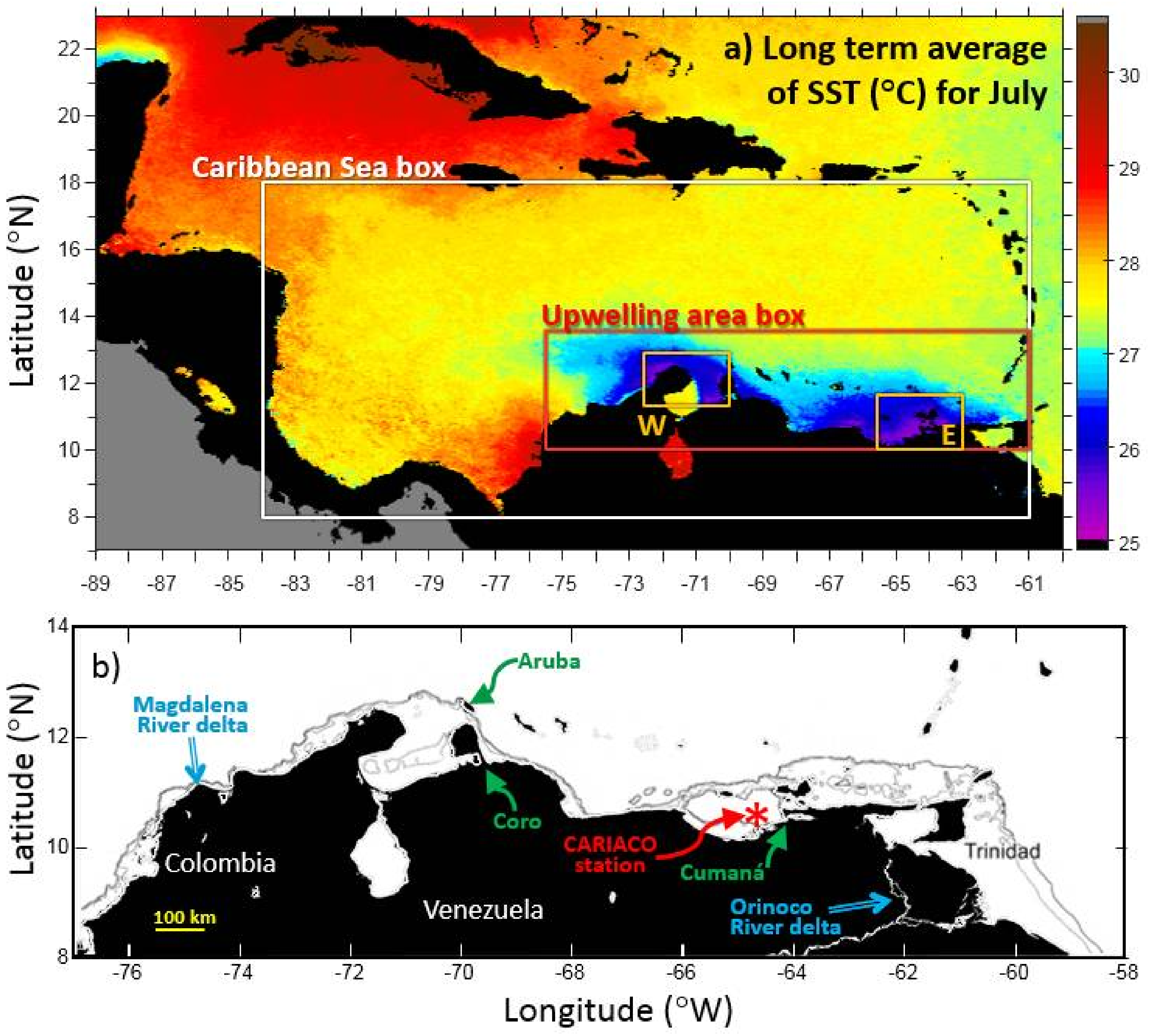
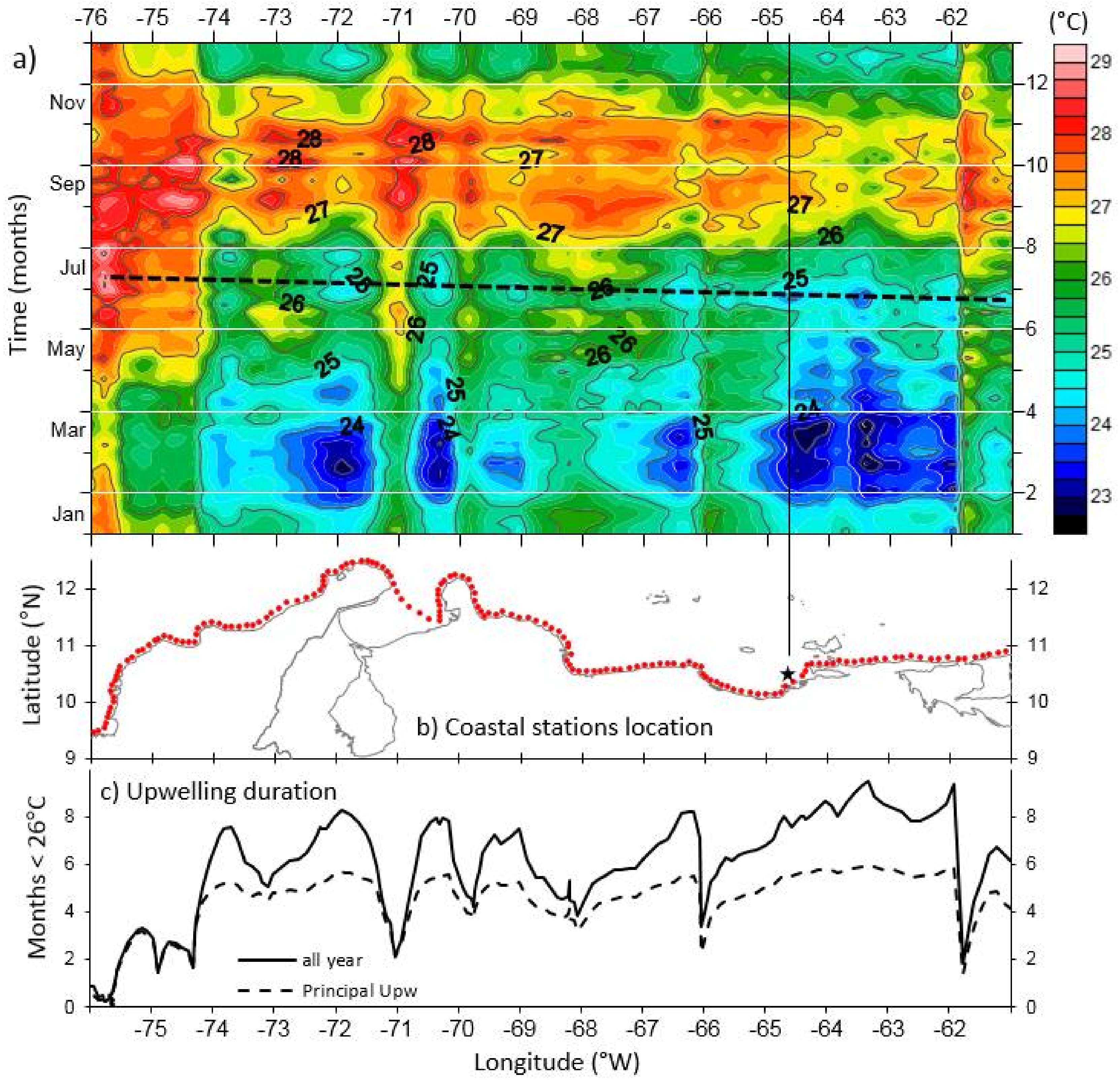
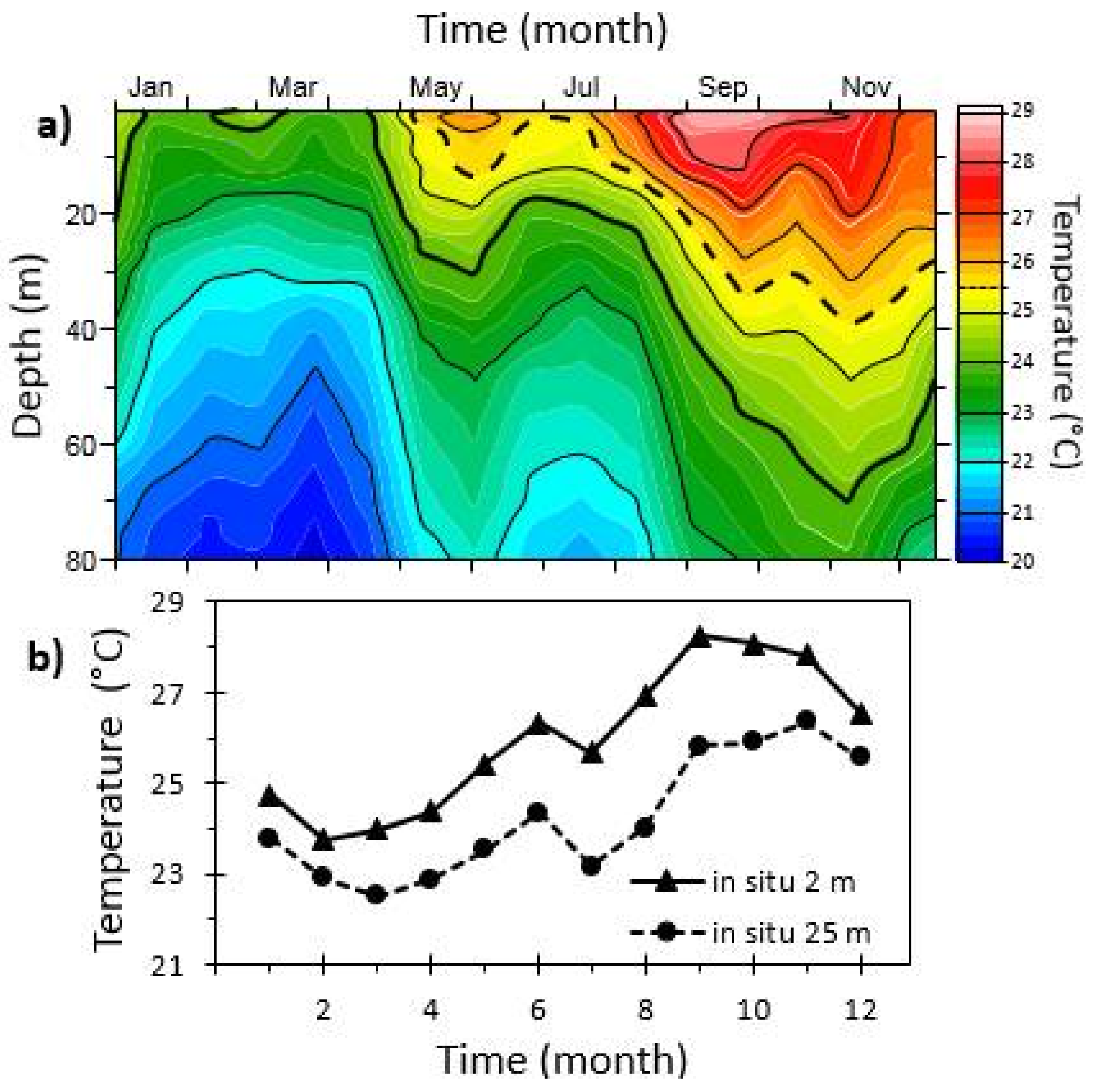
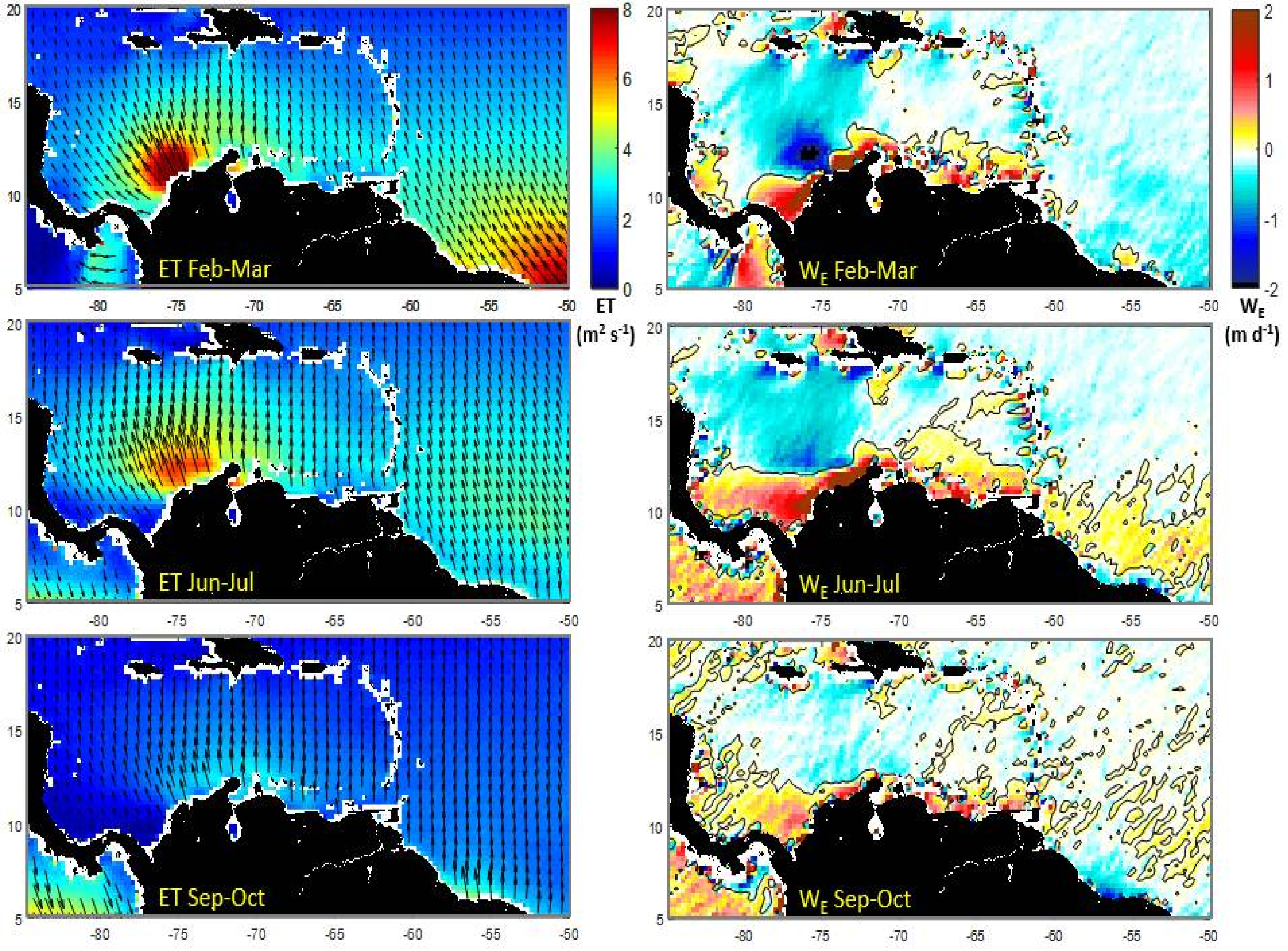
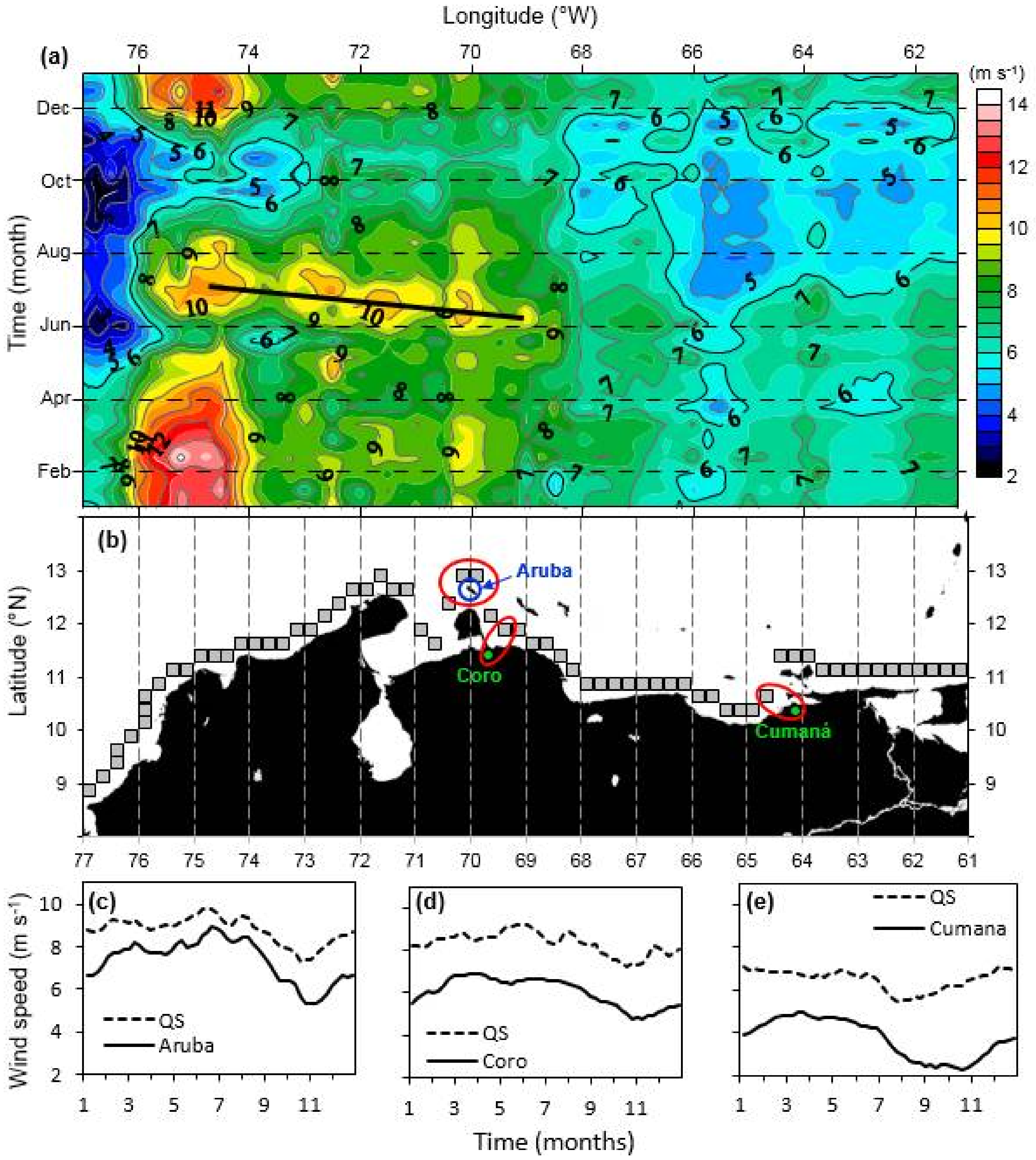

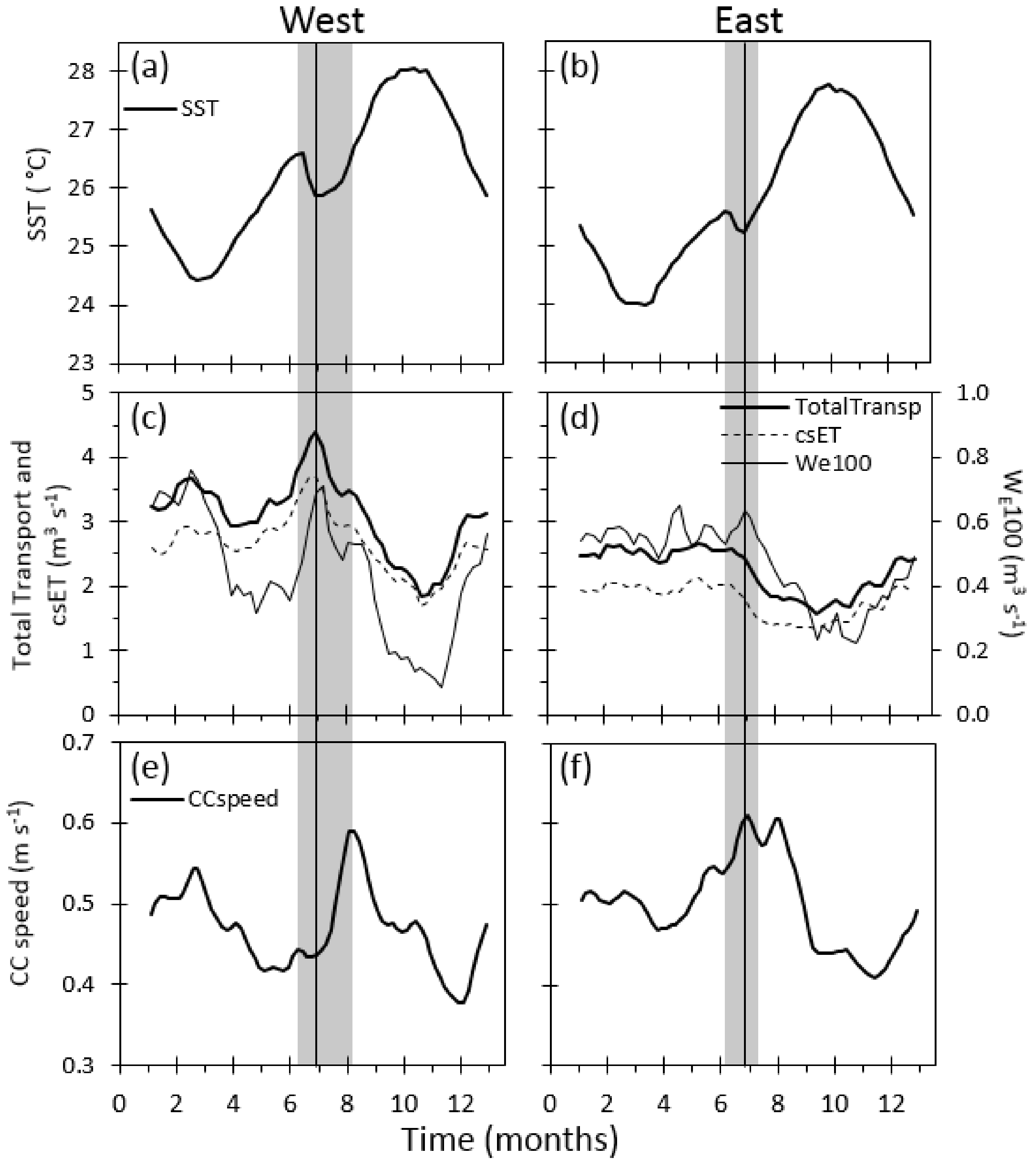
| Variable | Area | Annual | (SD) | December–April | (SD) | February–March | (SD) | June–August | (SD) | September–October | (SD) |
|---|---|---|---|---|---|---|---|---|---|---|---|
| SST | E | 25.82 | (1.38) | 24.76 | (0.93) | 24.05 | (0.67) | 26.05 | (0.93) | 27.66 | (0.60) |
| (°C) | W | 26.26 | (1.29) | 25.18 | (0.85) | 24.52 | (0.58) | 26.46 | (0.78) | 27.96 | (0.50) |
| csET | E | 1.67 | (0.52) | 1.85 | (0.51) | 1.86 | (0.53) | 1.49 | (0.43) | 1.42 | (0.35) |
| (m3 s−1) | W | 2.58 | (0.92) | 2.61 | (0.73) | 2.71 | (0.71) | 3.02 | (0.77) | 1.95 | (0.93) |
| WE100 | E | 0.46 | (0.32) | 0.54 | (0.31) | 0.55 | (0.30) | 0.50 | (0.27) | 0.26 | (0.34) |
| (m3 s−1) | W | 0.43 | (0.36) | 0.56 | (0.37) | 0.62 | (0.38) | 0.53 | (0.30) | 0.17 | (0.27) |
| CCspeed | E | 0.49 | (0.10) | 0.47 | (0.08) | 0.49 | (0.08) | 0.57 | (0.10) | 0.45 | (0.09) |
| (m s−1) | W | 0.47 | (0.11) | 0.47 | (0.11) | 0.48 | (0.12) | 0.51 | (0.14) | 0.46 | (0.09) |
| CClat | E | 13.3 | (1.07) | 12.93 | (0.94) | 12.94 | (0.75) | 13.55 | (1.13) | 13.48 | (0.99) |
| (°N) | W | 14.3 | (0.94) | 14.25 | (0.95) | 14.1 | (0.87) | 14.09 | (0.92) | 14.71 | (0.88) |
| SST W | SST E | |||||||
|---|---|---|---|---|---|---|---|---|
| TS | Anomalies | TS | Anomalies | |||||
| csET | −0.38 | L | −0.35 | L | −0.46 | L | −0.25 | L |
| WE100 | −0.52 | L | −0.35 | L | −0.44 | L | −0.35 | L |
| csET + WE100 | −0.48 | L | −0.41 | L | −0.54 | L | −0.36 | L |
| CCspeed | −0.18 | −0.19 | −0.25 | −0.28 | ||||
| CClat | 0.23 | ns | 0.17 | L | ns | |||
© 2018 by the authors. Licensee MDPI, Basel, Switzerland. This article is an open access article distributed under the terms and conditions of the Creative Commons Attribution (CC BY) license (http://creativecommons.org/licenses/by/4.0/).
Share and Cite
Rueda-Roa, D.T.; Ezer, T.; Muller-Karger, F.E. Description and Mechanisms of the Mid-Year Upwelling in the Southern Caribbean Sea from Remote Sensing and Local Data. J. Mar. Sci. Eng. 2018, 6, 36. https://doi.org/10.3390/jmse6020036
Rueda-Roa DT, Ezer T, Muller-Karger FE. Description and Mechanisms of the Mid-Year Upwelling in the Southern Caribbean Sea from Remote Sensing and Local Data. Journal of Marine Science and Engineering. 2018; 6(2):36. https://doi.org/10.3390/jmse6020036
Chicago/Turabian StyleRueda-Roa, Digna T., Tal Ezer, and Frank E. Muller-Karger. 2018. "Description and Mechanisms of the Mid-Year Upwelling in the Southern Caribbean Sea from Remote Sensing and Local Data" Journal of Marine Science and Engineering 6, no. 2: 36. https://doi.org/10.3390/jmse6020036




